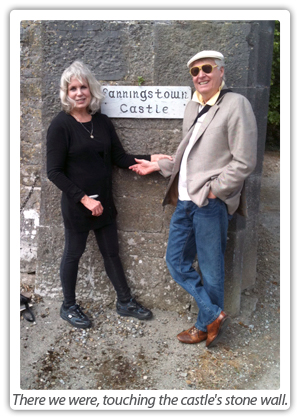
Have you ever had a relative who was being hunted down by the military?
My wife has.
Around 1650, Oliver Cromwell’s English generals came after my wife’s relative, Edmund Fanning, who resided in Limerick County, Ireland.
Edmund Fanning was part of the Irish resistance of 1649-50. His Fanningstown Castle was to be confiscated by invading English forces.
Fanning had refused to become part of the Church of England. Instead, he remained loyal to his Irish Catholic roots.
Because of this, Edmund probably decided that a brighter and safer future awaited him in America. Sometime in 1653, he, along with his family, sailed to the American colony of Connecticut.
Little did Edmund know that his posterity would again be fighting the British 126 years later in the Revolutionary War of 1776. And, irony of ironies, they would be fighting alongside the British in World Wars I and II.
My personal Observations
I had no idea that such a story existed until Cheri and I visited Ireland last week.
I was fascinated by the account of Edmund Fanning and Fanningstown Castle. Just think, my wife was related to a person who lived in an Irish castle in 1650. And I was touching the stone wall that Edmund probably touched hundreds of times.
I was having one of those private emotional awakenings. I was experiencing the profundity of the obvious, “everything is not in the here and now, and history is long, and I’m just a blip on the history of time.” This is an important insight for a person like myself, who believes the only thing that exists is what exists right now.
I was inspired to write about Edmund Fanning, but my wife resisted. She has been working hard for the past two years putting together her Irish family history. As she was to find out, fitting all the pieces of the family tree together is difficult and at times verges on the near impossible.
Indeed, she is related to Edmund. But, how exactly she is related requires greater clarity. Even though Cheri is a Fannin(g), Limerick County, at that time, was full of Fannings. Fannings came to America at different times, while others stayed in Ireland. I began to realize that any such undertaking should be done with a great deal of caution.
My admiration for professional historians grew with this experience. We need to know what happened in our past, and be able to recreate it accurately. To do so requires rigorous training and discipline. It’s important to get the facts of history right. If not, all we are engaged in is quaint and speculative story telling.
Anyway . . .
It’s still very emotionally satisfying to know that my wife’s distant relative, and by extension my children’s and grandchildren’s relative, was involved with one of the central figures in Western Civilization. For this much we know: Oliver Cromwell was a major influence in overthrowing the monarchy of England in 1649, and establishing the supremacy of parliamentary rule.
To do this, Cromwell was responsible for having English King Charles I beheaded.
Afterward, we know that Cromwell turned his attention to Ireland. Ireland resisted English Protestant “Parliamentary Rule.” The Irish remained stubbornly Catholic, and violently opposed to English intrusion.
Most probably feeling the heat of Cromwell’s generals pressing down on him, Edmund sailed to America. This makes sense, because one of Edmund’s close relatives, Dominick, the Mayor of Limerick, and one of the leaders in the Irish resistance, was hung by order of one of Cromwell’s generals. In addition, Cromwell was upset that Edmund was able to maintain ownership of Fanningstown Castle.
And so . . .
There we were last week, touching the castle’s stone wall. Indeed, history is long, and we were connected to it in a very real way.